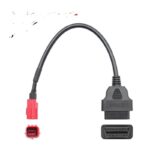For car owners and enthusiasts alike, understanding the inner workings of your vehicle can feel like deciphering a complex code. Modern cars are sophisticated machines, relying heavily on onboard computers and sensors. When that check engine light illuminates on your dashboard, it’s your car’s way of saying something needs attention. This is where an OBD2 diagnostic tool becomes an invaluable asset. But what exactly can an OBD2 diagnostic tool do for you? Let’s delve into the capabilities and limitations of these powerful devices.
One common question is about the necessity of companion apps. While some OBD2 tools offer optional mobile applications to enhance functionality, it’s important to understand that you can use an OBD2 diagnostic tool effectively even without them. These apps often provide a more user-friendly interface and additional features like pre-verified repair solutions, data logging, and access to technical service bulletins. However, the core function of reading diagnostic trouble codes (DTCs) and accessing live data is typically available directly through the OBD2 scanner itself. Think of the app as a helpful assistant, not a mandatory component for basic diagnostics.
Another frequent concern revolves around costs. The good news is that basic functionality, including software updates, for reputable OBD2 diagnostic tools is generally free of charge after the initial purchase of the device. You can expect to receive ongoing support and updates without recurring subscription fees for many tools on the market, ensuring your device remains compatible with newer vehicles and diagnostic protocols. This makes an OBD2 scanner a one-time investment in your car’s health and your peace of mind.
Geographical compatibility is another crucial factor to consider. While OBD2 standards are globally recognized, the implementation and specific protocols can vary slightly by region. Therefore, a key question is, ” can this OBD2 diagnostic tool work in my country?”. For users in the United States and Canada, most OBD2 tools are designed to be fully compatible with North American vehicle protocols. However, it’s essential to verify compatibility if you reside outside of these regions. For instance, some tools might have limited functionality or not work at all outside of North America due to regional protocol differences. Even within North America, vehicles imported from other regions might have specific requirements. Always check the manufacturer’s specifications to confirm the geographical compatibility of your chosen OBD2 scanner.
Vehicle compatibility extends beyond just region to the specific make, model, and year of your car. While OBD2 is designed as a universal standard, the depth of diagnostic capabilities can vary depending on your vehicle. Most OBD2-compliant vehicles, which include almost all cars and light trucks sold in North America since 1996, will be compatible with a standard OBD2 scanner for basic diagnostics like reading engine and transmission codes. However, advanced features such as accessing ABS, SRS, or body control module codes, or performing advanced functions like resets and calibrations, might be limited or unavailable on certain vehicles due to variations in manufacturer implementation and communication protocols. To ensure your chosen tool can fully support your vehicle’s systems, always utilize a compatibility checker provided by the tool manufacturer. These checkers usually allow you to input your vehicle’s year, make, and model to confirm the level of diagnostic support offered.
Vehicles manufactured by Fiat Chrysler Automobiles (FCA), such as Jeep, Chrysler, Dodge, and Ram, present a specific compatibility scenario. For older FCA vehicles manufactured in 2017 or earlier, many OBD2 tools can diagnose all systems effectively. However, newer FCA vehicles from 2018 onwards introduce an additional layer of security called AutoAuth. AutoAuth restricts access to certain diagnostic functions unless the tool is authorized. Standard handheld OBD2 scanners and dongles generally cannot bypass AutoAuth. While they might still perform basic functions like reading TPMS data and live engine parameters on newer FCA vehicles, critical functions like clearing codes, performing oil resets, or battery initialization will be restricted. If you own a newer FCA vehicle and require full diagnostic capabilities, you will need to consider specialized OBD2 tools that offer AutoAuth access, such as advanced scan tablets.
It’s also crucial to understand the limitations of OBD2 diagnostic tools in terms of vehicle computer programming and key fob programming. Standard OBD2 scanners are primarily designed for diagnostics – reading error codes, monitoring live data, and sometimes performing basic resets. They cannot reprogram vehicle computers (ECUs) or program key fobs. Reprogramming ECUs and key fob programming are complex procedures that typically require specialized equipment and software beyond the scope of a standard OBD2 diagnostic tool. Attempting to perform these functions with an inappropriate tool can potentially damage your vehicle’s electronic systems.
Finally, a fundamental requirement for using any OBD2 diagnostic tool is that the vehicle must be able to at least crank or start. OBD2 scanners communicate with the vehicle’s electronic control units (ECUs), which require power to operate and communicate. If your vehicle cannot start or even crank due to a dead battery or a major mechanical issue, the OBD2 scanner will be unable to establish a connection with the ECU and retrieve diagnostic information. Therefore, ensure your vehicle has sufficient power to operate its electrical systems before attempting to use an OBD2 diagnostic tool.
In conclusion, an OBD2 diagnostic tool is a powerful instrument that can empower you to understand your car’s health, diagnose problems, and potentially save money on repairs. While they have limitations, particularly regarding advanced programming and compatibility with certain vehicle systems or regions, understanding what an OBD2 tool can and cannot do is crucial for effective vehicle maintenance and troubleshooting. By choosing the right tool for your needs and understanding its capabilities, you can unlock valuable insights into your vehicle’s performance and ensure it stays running smoothly for years to come.

